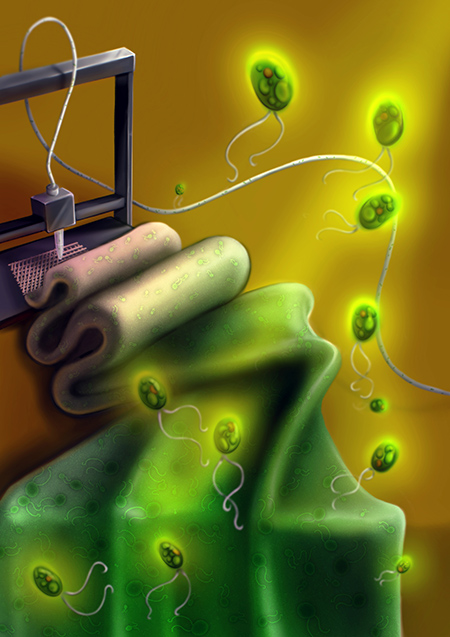博文
藻类制成的活体光合成材料及应用
||
藻类制成的光合成活体材料及应用
诸平

A mini T-shirt demonstrates the photosynthetic living materials created in the lab of University Rochester biologist Anne S. Meyer and Delft University of Technology bionanoscientist Marie-Eve Aubin-Tam using 3D printers and a new bioink technique. Credit: University of Rochester photo

据美国罗切斯特大学(University of Rochester)2021年5月4日提供的消息,一个国际研究小组首次使用3D打印机和一种新的生物打印技术将藻类打印成坚韧和有弹性的光合活体材料(photosynthetic living materials)。罗切斯特大学提供的照片,通过一件迷你T恤展示了罗切斯特大学生物学家安妮·迈耶( Anne S. Meyer)和荷兰德尔夫特理工大学(Delft University of Technology )生物纳米科学家玛丽-埃夫·奥宾-塔姆(Marie-Eve Aubin-Tam)利用3D打印机和一种新的生物墨水技术(bioink technique)在实验室中制造的光合活体材料(photosynthetic living materials)。
活体材料(Living materials)是由非活基质(non-living matrix)内的生物细胞构成的,近年来越来越受欢迎,因为科学家认识到,最坚固的材料往往是模仿自然的材料。
来自美国罗切斯特大学和荷兰德尔夫特理工大学的一个国际研究小组首次使用3D打印机和一种新的生物打印技术将藻类打印成坚韧和有弹性的活体光合作用材料。该材料在能源、医疗和时尚领域具有多种应用。这项研究结果于2021年4月29日在《高级功能材料》(Advanced Functional Materials)杂志网站发表——Srikkanth Balasubramanian, Kui Yu, Anne S. Meyer, Elvin Karana, Marie‐Eve Aubin‐Tam. Bioprinting of Regenerative Photosynthetic Living Materials. Advanced Functional Materials, First published: 29 April 2021; 2011162. DOI: 10.1002/adfm.202011162. https://onlinelibrary.wiley.com/doi/10.1002/adfm.202011162
德尔夫特理工大学博士后研究员、此论文第一作者斯里坎特·巴拉苏布拉马尼安(Srikkanth Balasubramanian)说:"3D打印是制造活功能材料的有力技术,在广泛的环境和人本应用(human-based applications)中具有巨大的潜力。我们提供了首例工程化的光合作用材料,这种材料在物理上足够坚固,可以部署在现实生活的应用之中。
如何构建新材料:活体和非活体部分(How to build new materials: Living and nonliving components)
为了制造光合作用材料,研究人员首先研究了一种非活性细菌纤维素(non-living bacterial cellulose)——一种由细菌产生和排泄的有机化合物。细菌纤维素(Bacterial cellulose)具有许多独特的机械特性,包括其灵活性(flexibility)、韧性(toughness)、强度(strength)和保持其形状的能力,即使扭曲、粉碎或其它方面的物理扭曲等。
细菌纤维素就像打印机中的纸张一样,而活体微藻作为墨水。研究人员使用3D打印机将活体藻沉积在细菌纤维素上。
活体(微藻)和非活体(细菌纤维素)成分的结合产生了一种独特的材料,具有藻类的光合作用品质和细菌纤维素的坚固性:该材料坚固且具有弹性,同时具有环保、可生物降解、简单且可扩展生产。这种材料的植物状性质意味着它可以使用光合作用在几周内"喂养"自己,而且它也能够再生——可以在现场种植少量材料样本,以制造更多的材料。
人造叶子、光合作用皮肤和生物服装(Artificial leaves, photosynthetic skins, and bio-garments)
该材料的独特特性使其成为各种应用的理想候选产品,包括人造叶片、光合作用皮肤(photosynthetic skins)或光合作用生物服装(photosynthetic bio-garments)等新产品。
人造叶子(Artificial leaves)是模仿实际叶子的材料,因为它们利用阳光将水和二氧化碳(气候变化的主要驱动因素)转化为氧气和能量,就像光合作用过程中的叶子一样。叶子以化学形式储存能量作为糖,然后可以将糖转化为燃料。因此,人造叶子提供了一种在植物无法生长的地方(包括外层空间殖民地)产生可持续能源的方法。德尔夫特大学和罗切斯特大学的研究人员生产的人造叶子是另外由环保材料制成的,与目前生产的大多数人工叶技术形成鲜明对比,后者是使用有毒化学方法生产的。
罗切斯特大学生物学副教授安妮·迈耶说:"对于人造叶子来说,我们的材料就像是植物的'最佳部分'——叶子——可以创造可持续的能量,而不需要利用资源来生产植物的某些部分——茎和根——它们需要资源,但不能产生能量。我们正在制造一种只专注于能源可持续生产的材料。"
安妮·迈耶说,这种材料的另一个应用是光合作用皮肤,可用于皮肤移植。产生的氧气有助于启动受损区域的愈合,或者它能够进行光激活的伤口愈合。
除了提供可持续的能源和医疗,这些材料还可以改变时尚行业。由藻类制成的生物服装(Bio-garments)将解决当前纺织业的一些负面环境影响,因为它们将是高品质的面料,能够产生可持续性和完全可生物降解。它们还将通过光合作用去除二氧化碳来净化空气,并且不需要像传统服装那样经常清洗,从而减少用水。
德尔夫特大学生物纳米科学副教授玛丽-埃夫·奥宾-塔姆(Marie-Eve Aubin-Tam)表示:"我们的活体材料很有前途,因为它们在没有水或营养物质的条件下可以存活数天,而且这种材料本身可以用作种植新生物材料的种子。这为在偏远地区(甚至在空间)应用打开了大门,在那些无水无营养物质的地方这种材料也可以借助阳光在现场播种。上述介绍仅供参考,欲了解更多信息敬请注意浏览原文或者相关报道。
Living materials, which are fabricated by encapsulating living biological cells within a non‐living matrix, have gained increasing attention in recent years. Their fabrication in spatially defined patterns that are mechanically robust is essential for their optimal functional performance but is difficult to achieve. Here, a bioprinting technique employing environmentally friendly chemistry to encapsulate microalgae within an alginate hydrogel matrix is reported. The bioprinted photosynthetic structures adopt pre‐designed geometries at millimeter‐scale resolution. A bacterial cellulose substrate confers exceptional advantages to this living material, including strength, toughness, flexibility, robustness, and retention of physical integrity against extreme physical distortions. The bioprinted materials possess sufficient mechanical strength to be self‐standing, and can be detached and reattached onto different surfaces. Bioprinted materials can survive stably for a period of at least 3 days without nutrients, and their life can be further extended by transferring them to a fresh source of nutrients within this timeframe. These bioprints are regenerative, that is, they can be reused and expanded to print additional living materials. The fabrication of the bioprinted living materials can be readily up‐scaled (up to ≥70 cm × 20 cm), highlighting their potential product applications including artificial leaves, photosynthetic bio‐garments, and adhesive labels.
https://blog.sciencenet.cn/blog-212210-1285330.html
上一篇:声称生命力能杀死癌细胞的 “奇迹医生”之文被撤
下一篇:“分子胶”使钙钛矿太阳能电池更加稳定可靠